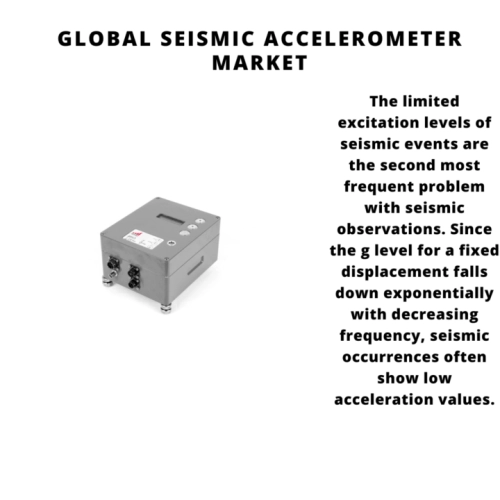
- Get in Touch with Us

Last Updated: Apr 25, 2025 | Study Period: 2022-2030
Studies on seismic vibrations are well suited for piezoelectric accelerometers. They operate entirely independently and generate themselves using an inertial frame of reference. This resolves the relative vibration issues that can be encountered with optical/laser systems as well as dual ended attachment coil-based solutions, like LVDTs.

The limited excitation levels of seismic events are the second most frequent problem with seismic observations. Since the g level for a fixed displacement falls down exponentially with decreasing frequency, seismic occurrences often show low acceleration values.
The naturally high output and extremely low noise floor of piezoelectric accelerometers, along with their integrated ICP impedance conversion electronics, enable them to meet this measurement challenge.
These features are hermetically sealed inside a stainless steel sensor housing that has been laser welded. This combination can drive low impedance, noise-resistant signals while offering effective broadband resolutions on the order of one micro g.
The capacity to drive lengthy cable runs commonly associated with seismic installations on bridges, buildings, or other civil infrastructures is another advantage of ICP low output impedance transducers. The solid state aspect of the sensor's fabrication is the last advantage of piezoelectric acceleration sensing.
When compared to servo or flexure based systems, the sensors are far more rugged/reliable and can run for extended periods of time in outdoor situations because they have no moving parts and a sealed stainless steel housing.
Due to these factors, piezoelectric seismic accelerometer arrays are frequently used in applications such as monitoring civil infrastructure, vibration limit switches, and operating modal deflection shape assessment.
There are only a few issues with piezoelectric seismic accelerometers to take into account. Keep in mind that all piezoelectric devices are AC linked. The accelerometer's discharge time constant controls its low frequency response.
TheGlobal Seismic Accelerometer Market accounted for $XX Billion in 2021 and is anticipated to reach $XX Billion by 2030, registering a CAGR of XX% from 2022 to 2030.
The "Yure Mon Hyper" seismic intensity metre, made by Tokyo-based Knowledge Foresight Inc. and fitted with an Epson M-A352 high-performance three-axis accelerometer, has been certified by the Japan Meteorological Agency, according to Seiko Epson Corporation (JMA). The seismic intensity metre from Knowledge Foresight is the second seismic intensity metre to be certified using Epson's M-A352 accelerometer; the first being the LA-352 seismic intensity metre made by Tokyo-based Clovertech Inc.
The accelerometers made by Epson have a great reputation for exceptional performance and quality and have been used in a variety of applications. The demand for improved, more precise technologies for sensing and monitoring occurrences like tsunamis and regular earthquakes has increased in recent years. Due to this, systems utilising seismic intensity metres with very accurate accelerometers are in high demand.
In accordance with Japan's Meteorological Service Act, the JMA only uses certified meteorological instruments1 in its meteorological observation sites. The JMA will subject other devices to the same testing as meteorological instruments if a device user wants certification to ensure accuracy even if this most recent seismic intensity metre is not categorised as a meteorological instrument. Strict requirements must be met by instruments used for meteorological observation and measurement.
| Sl no | Topic |
| 1 | Market Segmentation |
| 2 | Scope of the report |
| 3 | Abbreviations |
| 4 | Research Methodology |
| 5 | Executive Summary |
| 6 | Introduction |
| 7 | Insights from Industry stakeholders |
| 8 | Cost breakdown of Product by sub-components and average profit margin |
| 9 | Disruptive innovation in the Industry |
| 10 | Technology trends in the Industry |
| 11 | Consumer trends in the industry |
| 12 | Recent Production Milestones |
| 13 | Component Manufacturing in US, EU and China |
| 14 | COVID-19 impact on overall market |
| 15 | COVID-19 impact on Production of components |
| 16 | COVID-19 impact on Point of sale |
| 17 | Market Segmentation, Dynamics and Forecast by Geography, 2022-2030 |
| 18 | Market Segmentation, Dynamics and Forecast by Product Type, 2022-2030 |
| 19 | Market Segmentation, Dynamics and Forecast by Application, 2022-2030 |
| 20 | Market Segmentation, Dynamics and Forecast by End use, 2022-2030 |
| 21 | Product installation rate by OEM, 2022 |
| 22 | Incline/Decline in Average B-2-B selling price in past 5 years |
| 23 | Competition from substitute products |
| 24 | Gross margin and average profitability of suppliers |
| 25 | New product development in past 12 months |
| 26 | M&A in past 12 months |
| 27 | Growth strategy of leading players |
| 28 | Market share of vendors, 2022 |
| 29 | Company Profiles |
| 30 | Unmet needs and opportunity for new suppliers |
| 31 | Conclusion |
| 32 | Appendix |